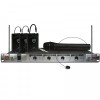Nady 401X Manual - Page 15
On/standby/off Switch 37, Low Battery Indicator Led 36, Af Level Led Display 7, Volume Lo/hi Gain,
 |
View all Nady 401X manuals
Add to My Manuals
Save this manual to your list of manuals |
Page 15 highlights
OPERATION 4. Microphone Operation a. Turn on The Link 2 by sliding the ON/STANDBY/OFF SWITCH (37) to the STANDBY position (transmitter on, audio muted) or the ON position (transmitter and audio both on). The LOW BATTERY INDICATOR LED (36) will give a single quick flash, indicating usable battery strength. In case of dead or low battery, the indicator will either not go on at all or stay on continuously, indicating a battery voltage below 7V. If this occurs, replace with a fresh 9V battery. Remember to turn the transmitter off when not in use. b. The Link 2 is now ready to use. The AF LEVEL LED DISPLAY (7) on the 401X Quad receiver should now be lit, indicating a received signal from the transmitter. When ready to speak, slide the transmitter switch to the ON position and adjust the volume of the receiver as per the Audio Output Microphone Connection section of the above 401X Quad receiver instructions. The AF LEVEL LED DISPLAY (7) on the 401X Quad receiver will light up as if the input signals are getting stronger. Occasional flickering on and off during use of the LED indicator is normal. However, if the LED stays on continuously, it means the signal is too loud and there is the possibility of overload distortion. Re-position the microphone farther from the source or adjust the Link 2 transmitter gain with the VOLUME LO/HI GAIN SWITCH (35). Set for the maximum possible level without noticeable distortion on the high level peaks. Set the GAIN SWITCH to LO to decrease the audio level, and set the GAIN SWITCH to HI to increase the audio level. The red LED indicator should flicker only on the loudest inputs. [Note: Observe care in selecting P.A. volume, transmitter location and speaker placement so that acoustic feedback (howling and screeching) will be avoided. Please also observe the pickup patterns of the microphone selected: omnidirectional mics pick up sound equally from all directions and are prone to feedback if not used carefully. Unidirectional mics are more resistant to feedback, but pick up sound sources best that are directly in front of the mic. Also, mics that are farther from the sound source, such as lavaliers, require more acoustic gain and thus are also more prone to feedback than close-source mics such as handheld or headworn mics that are used close to the mouth.] (Note: Microphone elements can easily be destroyed by the buildup of salts and minerals from perspiration and saliva. It is good practice to put a windscreen on the mic element at all times to protect it.) 15














